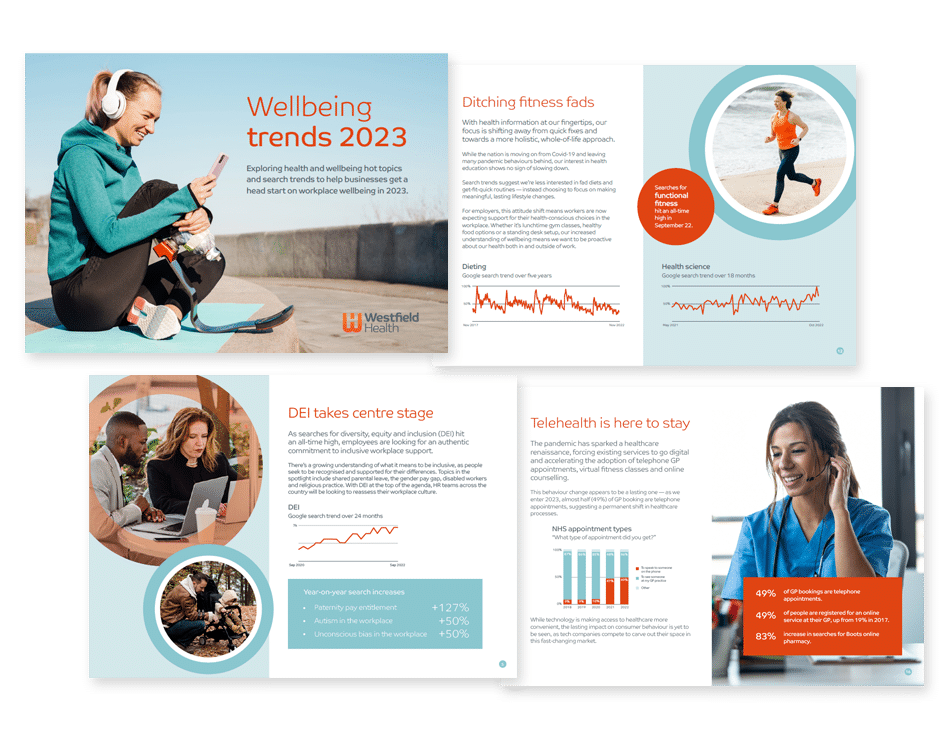In last year’s Wellbeing Trends 2022 report, we shared our research into the biggest trends and topics in health and wellbeing for 2022. Since then, many of the trends have developed to have a significant impact on workplaces across the country.
As businesses move on from the pandemic, we’re starting to discover which behaviours and workplace habits are here to stay. In this blog we take a look back at the wellbeing trends of 2022 and how they’ve shaped our predictions for 2023.
Post-Covid community and workplace DEI
As we emerged from lockdowns and social distancing in early 2022, many of us began looking for a new sense of community. Google searches for ‘social sports’ rose significantly while searches for ‘loneliness’ decreased by around 50%, suggested that people were keen to find ways to come together and reconnect.
This trend continues to develop as we enter 2023, with technology allowing us to be ‘together from afar’ and continued homeworking giving many workers a glimpse into their colleagues’ lives like never before.
With this renewed sense of togetherness comes an expectation that diversity will be acknowledged and supported in the workplace. Topics including the menopause, neurodiversity and parental leave have all hit the headlines in 2022 and this trend shows no signs of slowing down.
Searches for ‘DEI’ have more than doubled in the past two years, as people seek to better understand how they can foster a supportive environment and open the dialogue around diversity, equity and inclusion at work.
Financial worries have hit crisis point
Financial wellbeing has been high on the agenda for over a year, but 2022 has revealed the full extent of the cost-of-living crisis. In last year’s trends report we wrote about the looming threat of energy bill hikes and rising inflation, but the true impact of the crisis – on both our wallets and our mental health – continued to grow as the year went on.
Google searches for ‘cost-of-living’ increased by 4,555% in 2022, and the BACP reported that two thirds (66%) of therapists say financial concerns are causing a decline in people’s mental health.
Unfortunately, this trend looks set to continue into the new year, with increased costs causing anxiety amongst businesses and individuals alike. As tech giants such as Meta and Amazon start scaling back their workforce, 2023 could see a significant change in the job market.
Health awareness vs health anxiety
In our 2022 trends report we explored how the pandemic increased public awareness across all areas of health and wellbeing, putting us in touch with our needs and equipping us with a wealth of new health information.
With searches for ‘health science’ and ‘private medical insurance’ still on the up, it seems clear that people are looking to take an informed, preventative approach to their own healthcare. But with pressure on the NHS continuing to rise, anxiety around healthcare provision looks set to be a key factor driving people to invest in their wellbeing in 2023.
For businesses, this means employees could expect more health support at work. Cost-effective ways to invest in wellbeing include health cash plans, mental health support and flexible working options — our September research found these to be some of the most valued employee benefits.
The future workplace
2022 saw a transition from enforced homeworking to a variety of flexible models, as employers looked to define their own ‘new normal’. Almost three years since the first work-from-home order was announced, flexible and remote working have been adopted as standard practice in some sectors.
Our idea of what it means to work remotely is becoming more nuanced and technology is growing more sophisticated, with searches for ‘virtual office’ up 25% in the past year. As we enter the new year this trend will continue to evolve, with many employers still debating how to make WFH tech work for them.
In the face of our increasingly digital workplaces, some employees are now looking to switch off and unwind. Searches for ‘occupational burnout’ continue to rise, suggesting that workers are still struggling with their work-life balance. In 2023, employers must consider how to balance digital and real-life connections and provide meaningful support to their people from afar.
Download our 2023 Wellbeing Trends report
For more about this year’s upcoming workplace wellbeing trends, download our yearly Wellbeing Trends report. It explores emerging workplace health and wellbeing topics to give you a head start on employee wellbeing in 2023.
The report uses data from sources including the Office for National Statistics, the NHS, Google search trends and our own wellbeing research to help you plan and prioritise your wellbeing support.
